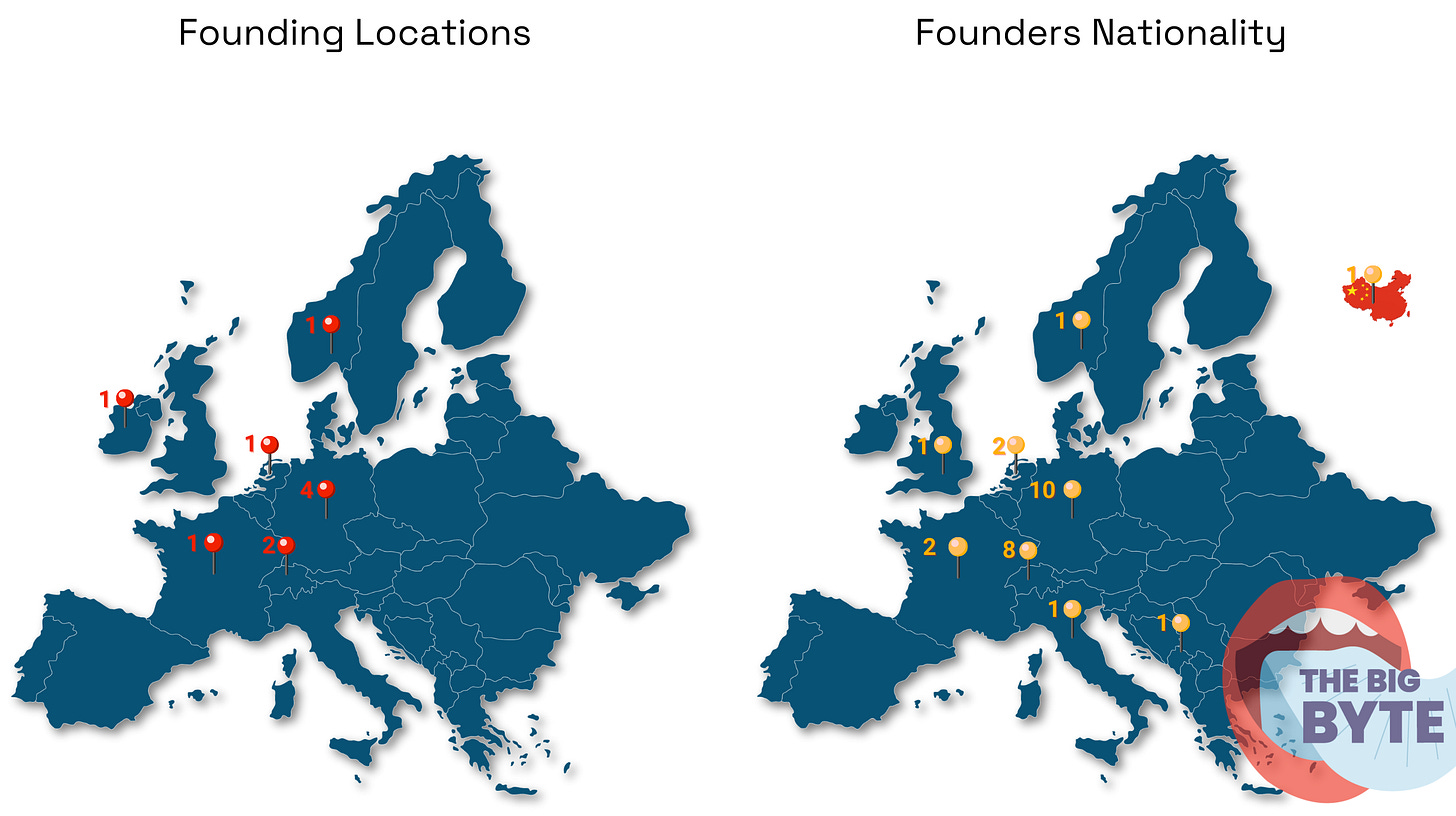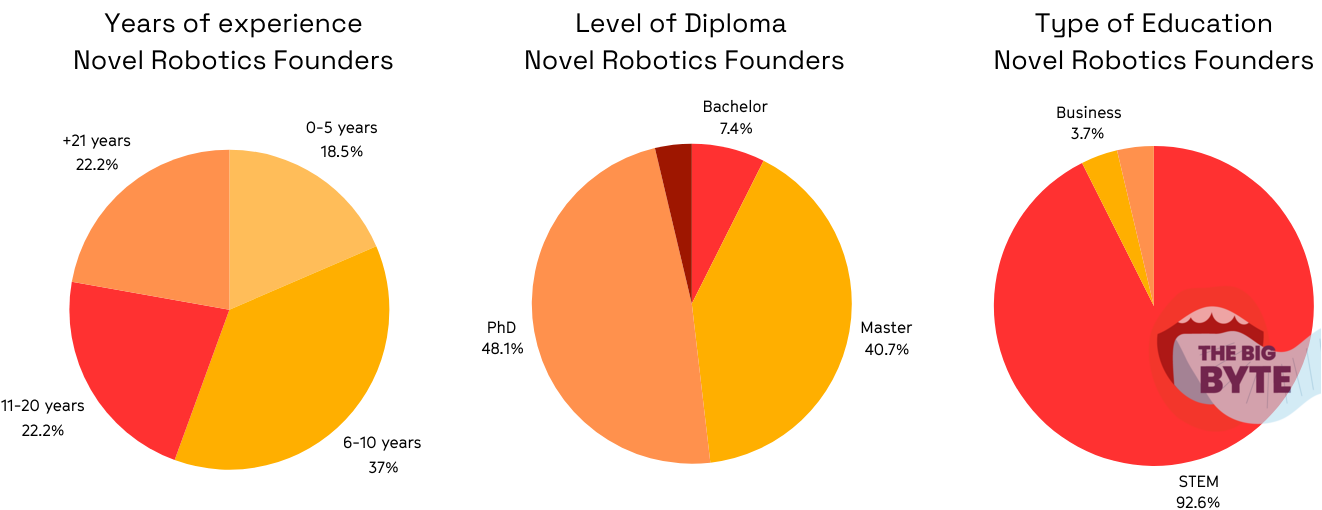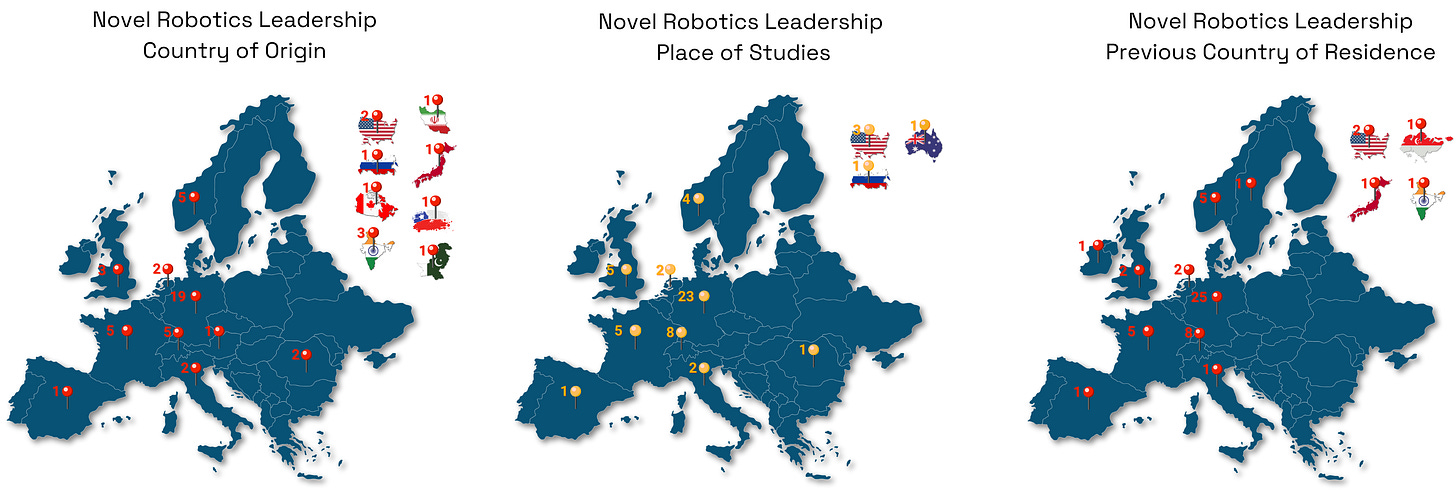The Technical Leaders Behind Europe's Novel Robotics Champions
Building advanced robots isn’t just a technical challenge - it’s a talent challenge.
This week, we're back with further explorations into European DeepTech.
We're looking at the leadership teams of 10 European Novel Robotics companies in areas like R&D, Product, Technology, Engineering, and AI. We wanted to do a pulse check on the leadership pool that is driving the technological progress in these companies. Where do these leaders come from? What experience do they bring to the table? Where will future leaders come from?
Our selection is based on Dealroom’s mapping of Europe’s cutting-edge robotics startups.
There's a lot of expectation on robotics to be the next break-out field that upends and changes the world we live in. And Europe is emerging as a strong contender in the next wave of robotics. Backed by world-class research institutions, a strong industrial base, robust public-private partnerships, and a new generation of tech startups, Europe now holds about 32% of the global robotics market. The continent is also benefiting from a growing VC interest, with funding in European Novel Robotics startups reaching $294M in 2024.
Yet the European Novel Robotics sector faces a familiar bottleneck: a shortage of experienced leadership talent who know how to take cutting-edge prototypes from the lab and scale them into real-world products. Building advanced robots isn’t just a technical challenge - it’s a talent challenge.
If you’re interested, we created a similar piece about the tech leadership teams of 30 European Defense DeepTech companies.
Who are the Founders?
To understand the talent driving this revolution, we first looked at the founders of 10 top European Novel Robotics startups. Several patterns emerged among these founding teams:
Team Size and Origin
On average, each startup was founded by 2.7 founders (teams ranged from solo founders to five-person founding teams).
These founders are overwhelmingly European - 96.3% hail from Europe, with the majority coming from Germany and Switzerland.
In fact, only one founder across all ten companies originated from outside Europe (Agile Robots’ Zhaopeng Chen, originally from China, who has spent over two decades working in Germany).
Experience in Robotics
These are not fresh graduates tinkering in a garage - the typical founder has 13.6 years of professional experience under their belt before launching their company (compare that to 7-10 years typically noted in European SaaS/B2C tech).
Importantly, a large majority (70.4%) have a background in robotics, whether through academia or industry.
And many cut their teeth in research: about 59% of the founders previously worked in academic laboratories or research centres, reflecting how closely robotics innovation is tied to academia.
Entrepreneurial Track Record
Nearly half (44.4%) of the founders had prior entrepreneurial experience - they’ve built companies before.
And notably, most of those serial entrepreneurs stuck to their roots: 58.3% of them had founded or led a robotics-related venture in the past. In other words, Europe’s robotics startup ecosystem is recycling talent. Seasoned founders are building again in the same domain, likely bringing with them stronger investor networks, better go-to-market instincts, and more operational discipline the second time around.
Roles and Expertise
The founders tend to occupy technical and leadership roles in their companies. Over half (59.3%) hold executive positions (with 37% serving as CEO of their company and 18.5% in technical executive roles like Chief Technology Officer or Chief Scientist).
The remainder mostly hold senior technical titles such as Head or Director of a department.
Tellingly, none of the founders in this cohort took on a dedicated commercial role (e.g. there were no founder Chief Commercial Officers or heads of sales). These startups were born from deep technical expertise, and even the founders focus on technology and R&D leadership, relying on others later to drive sales or operations.
The number of founders with prior robotics experience is notably higher than in our previous research on Defence DeepTech, though still lower than in the battery and energy sectors. Meanwhile, the prevalence of repeat entrepreneurs with robotics backgrounds shows a maturing ecosystem: talent is being “recycled” rather than coming entirely from first-timers.
Academia’s influence is another striking theme. In addition to many founders coming out of research labs, a substantial share of the startups themselves are academic spin-outs. Out of the ten companies analysed, three were spun out directly from universities or research. A 30% spin-out rate is well above the European average - for context, university-originated patents account for just ~10% of all patent filings in Europe. By the way: Europe’s only unicorn in Novel Robotics is itself a university spinout, underscoring a strong launchpad for turning academic breakthroughs into commercial success.
Speaking of DeepTech unicorns, we also analyzed the leadership composition of Wayve across every business function.
The Background of Technical Leaders
If founders set the vision, it’s the broader leadership team, particularly in R&D and engineering, that carries the innovation forward. We identified over 50 current and past leaders in R&D, product, engineering, AI, and technology across these ten companies, and analysed their demographics and career paths. The findings illuminate where Europe’s robotics leadership talent is coming from and where gaps remain.
A Stark Gender Gap
Perhaps the most bothersome statistic: 100% of these R&D and engineering leaders are male.
While it's generally understandable that DeepTech fields attract more men, it's unusual to find that in our talent sample, not a single woman has held a top technical leadership role at any of the ten robotics startups.
This is the first time in our various deep-tech talent studies that we’ve encountered an all-male cohort of leaders. It stands in stark contrast to the broader industry: across the EU, about 22.4% of professionals in science and engineering are female.
Homegrown Talent with Strong Academic Pedigrees
The pipeline for robotics leadership in Europe is largely homegrown and academically excellent. Over 80% of the leaders we studied are of European origin/nationality, and an even greater share - 91.2% - earned their degrees from European universities.
Many of those universities are among Europe’s best: Zurich’s ETH and Germany’s Technical University of Munich are the top two institutions, representing 14.3% and 12.5% of these individuals, respectively.
In total, more than 83% of the leaders spent over five years in higher education (often indicating a PhD or multiple degrees), and about 91% have a background in STEM fields. In short, Europe’s robotics companies are led by highly educated experts, usually trained in Europe’s own universities.
Leaders don’t stray far from Home.
A vast majority built their careers in Europe before taking on their current roles (91.2% had prior work experience primarily in Europe). Most were even hired from within the same country as their new employer - 76.7% were already based in the country where their startup is located.
Cross-border movement exists but is relatively modest: about 28.6% transitioned from a company with a different national affiliation than the startup they joined (for example, a French startup hiring a German engineer).
Only a small trickle of talent came directly from outside the region - just 7% of these leaders moved from companies based in Asia, and virtually none from North America.
It’s no surprise, then, that many of the leadership hires come from Europe’s robotics heartlands, especially the German-speaking DACH region. Germany ranks among the world’s top five robotics markets and leads Europe in robot density (429 industrial robots per 10,000 employees), while Zurich has emerged as a major hub with over 100 robotics and AI companies and the renowned ETH Robotic Systems Lab driving talent in the area. These hubs produce talent that largely stays within Europe’s borders to build local ventures.
Where do Companies find their R&D Leaders?
We also examined the professional backgrounds of these technical leaders to see where they were immediately before joining the startup.
Nearly half (48%) were recruited directly from other startups or scale-ups. Drilling down further, roughly 21.4% of the leaders had previously worked at a robotics startup or scale-up before (i.e. they had firsthand experience in a high-growth robotics company).
A significant portion - one-third (33.9%) - came straight out of academia or research institutions (universities, labs, etc.). The remainder, about 16.1%, were hired from established corporations. In other words, startups are drawing heavily from two main talent pools: the startup ecosystem itself and the academic/research world. Traditional corporations are a smaller feeder for these roles.
Indeed, our research underscores a key challenge: Europe’s deep-tech talent pool for robotics is limited, especially when it comes to leaders with prior startup scale-up experience. The fact that only ~21% of R&D leaders had worked at a robotics startup before joining their current role highlights this scarcity.
Many startups compensate for the lack of experienced startup veterans by tapping leaders from academia and research institutes. In essence, the public sector (universities, labs, and the talent they train) is playing an outsized role in providing leadership for private startups. This public-to-private talent transfer is a double-edged sword: it supplies highly skilled technical experts, but they may have a learning curve in the fast-paced, product-driven startup world. The reliance on institutional backgrounds to fill capability reinforces how crucial public investment in research and talent development is for the robotics industry, but it also underlines the need for more mentors and role models who have successfully scaled tech companies from adjacent industries to play their part.
Another finding is that these startups tend to hold on to their leaders once they have them. Leadership churn in our sample was low, around 16.1%. On average, a leader in a top technical role has been with their company for 3.4 years and about 2.4 years in their current specific role. This suggests relatively long tenures (especially by startup standards) and potentially that many joined in the early days and grew with the company. Good for stability, but can create a hiring bottleneck in a fast-growing sector.
Conclusion: Scaling in the European Novel Robotics Industry is as much a Talent Challenge as it is a Tech One
Robotics is a high-barrier, capital-intensive, and long-cycle sector that often starts in the lab. Strong public-private partnerships are essential to propel the European Novel Robotics industry forward and build a generation of successful companies. Our research confirms this: many founders previously worked in academic laboratories or research centres, and a notable share of companies are spinouts from universities and research institutions.
Yet, Novel Robotics doesn't escape Europe’s broader DeepTech challenges. There's a clear shortage of leaders with hands-on experience in robotics startups and scaleups. Once again, public-private collaboration appears to play a vital role, with many companies relying on leaders with an academic background to fill capability gaps and strengthen technical leadership.
Looking ahead, the transformative leap in robotics has the potential to reshape entire industries. But looking at the leadership talent landscape in Europe, we also see how early on in this journey we still are. To fulfil science fiction visions of the future, a few decades of building lie ahead.
If you wish to access our exclusive data file with over 50 leaders in product, engineering, AI, R&D, and technology at 10 European Novel Robotics companies, simply drop a message in the comments, and we’ll send it to you. 📥








